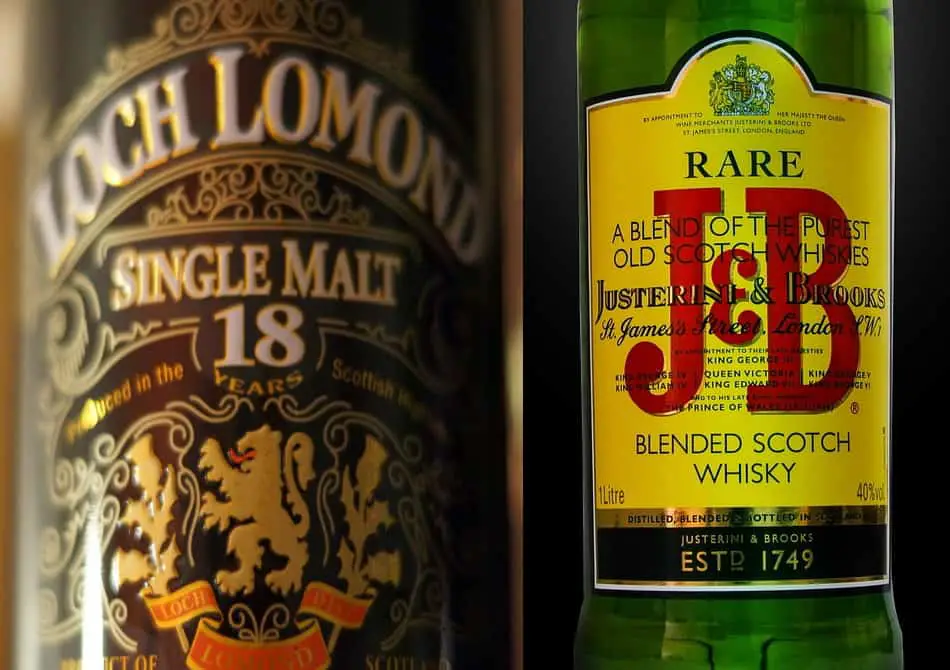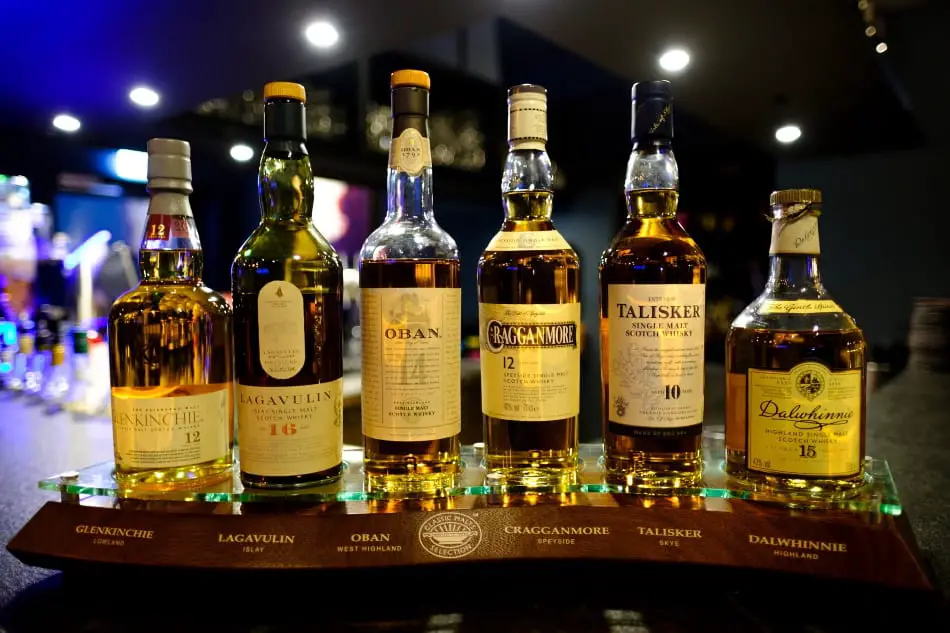Everyone’s heard of Scotch, and everyone’s heard of single malt, but what exactly is the difference between them and why is that important. Here’s everything you need to know.
The difference between Scotch and single malt is that Scotch is whisky made in Scotland, whereas single malt is whiskey made from malted barley that comes from one distillery. Scotches can therefore be single malts, but they can also be other types of whisky. Single malts can be Scotches, but they can also be whiskeys from other countries.
Let’s examine all that in more detail.

The Main Difference Between Scotch and Single Malt
Scotch
Scotch is whisky made in Scotland, as opposed to anywhere else in the world. There are several other legal criteria whiskies must meet in order to be called Scotch. They are:
- It must be made from water and malted barley. Other grains can be included but they must be whole grains.
- It must be distilled to an alcoholic strength of less than 94.8% ABV.
- It must be matured in used, oak barrels for at least three years.
- It must not contain any additional substances other than water and caramel coloring.
- It must be bottled at a minimum of 40%ABV.
While these criteria may seem quite constraining, there’s actually room for a huge amount of variety within them. So much so, that not only are there thousands of different Scotch whiskies, there are also five distinct types of Scotch. They are:
Single Malt
This is Scotch that’s made from 100% malted barley, which comes from a single distillery. It must also be distilled at least twice in a pot still. More on this in the next section.
Blended Malt
This is Scotch that’s made from a blend of two or more single malts from different distilleries.
Single Grain
This is Scotch that’s made from malted barley and other whole grains, which comes from a single distillery.
Blended Grain
This is Scotch that’s made from a blend of two or more single grain Scotches from different distilleries.
Blended
This is Scotch that’s made from one or more single malt Scotches and one or more single grain Scotches.
Single Malt
Before we can understand what single malt is, we must first understand what malting is.
Malting refers to the process of soaking barley in warm water, leaving it to partially sprout or germinate and then drying it in a kiln. This is done to break down the cellulose walls that contain the barley’s starch granules, so that they can be converted into sugars and then alcohol. Other grains are usually not malted but cooked instead.
Technically, any grain can be malted but after hundreds of years of whiskey making it has been confirmed that distillate produce from malted barley tastes better than distillate produced from other grains, even if they’re malted. Barley is also the easiest grain to malt. Which is why ‘malt whiskey’ means whiskey made from malted barley. (Whiskey made from other malted grains will have the specific grain in its name – e.g., Rye malt whiskey.)
Single malts are a type of malt whiskey. They have two basic criteria:
- They must be made from malted barley only.
- They must come from one distillery.
Since all whiskey producing countries make single malts, their criteria vary slightly. And since the legal criteria for whiskey in general also varies by country, single malts from different countries can be very different. Here are the different types of single malts produced by the main whiskey producing countries.
Single Malt Scotch
As well as the above basic criteria, single malts made in Scotland must be distilled at least twice in a pot still, and not distilled in a column still.
(A pot still has a bowl shape at the bottom, a narrow neck at the top and distills alcohol in batches. A column / continuous still has the shape of a column and distills alcohol continuously.)
Single Malt Irish Whiskey
Irish whiskey regulations are almost identical to Scotch whisky regulations, so their single malts must also, as well as the above criteria, be distilled at least twice in a pot still – although often they’re distilled three times for extra smoothness.
Single Malt American Whiskey
There is at the moment no legal definition for single malt American whiskey and technically, an American whiskey can be labelled as single malt even if it’s made from as little as 51% malted barley.
However, many single malt American whiskeys do adhere to the basic criteria for single malts and are made with malted barley only and come from one distillery.
But they don’t have to be distilled in pot stills and they do have to meet all the general criteria for being an American whiskey. And because that includes being aged in new, charred, oak barrels with no minimum aging period (unlike Scotch and Irish whiskey, which has to be aged in used oak barrels for a minimum of three years), they can be very different to other single malts.
Single Malt Japanese Whisky
There’s also no legal definition for single malt Japanese whisky, but since their industry’s pioneers modelled their product on Scotch, they typically follow the same criteria. They’re usually made from malted barley only, come from one distillery and are distilled in pot stills.

The Difference in Flavor Between Scotch and Single Malt
Now we’ve seen the main difference between Scotch and single malts, we can see another difference between them – flavor.
As mentioned, distillate produced from malted barley tastes better than distillate produced from other grains, even if they’re malted. It’s sweet and tastes of caramel, toffee and brown sugar. So single malts that are made from malted barley only, will taste better than non-single malt Scotches that contain less flavorful grain whiskies.
Also, pot stills produce a more flavorful distillate than column stills. This is because column stills produce a more concentrated distillate that has lost almost all the flavors from the grain, whereas distillate produced from pot stills is less concentrated, so it retains more flavor from the grain. Which makes sense when the grain in question is the more flavorful barley.
Pot stills come in many different shapes and sizes, both of which affects the flavor of the final product by altering how many flavor molecules will be collected. This is why single malts have a much wider variety of flavors than other whiskeys.
Lastly, single malts are matured in barrels (to pick up its flavors), for a lot longer than grain whiskeys. That’s because grain whiskeys become drinkable much sooner than malt whiskeys so they’re usually not left to become as flavorful as they could. As they’re going to be blended with several other grain and malt whiskeys anyway, the lack of flavor due to a shorter aging process is not that much of a problem.
On the other hand, single malts are left to age for a very long time. With sometimes decades spent picking up flavors from the wood of the barrel it’s matured in, it’s no wonder that single malts are usually much more flavorful than other types of whiskeys.
The Difference in Price Between Scotch and Single Malt
Of course, this leads us to the final difference between Scotch and single malts – price.
The table below shows the approximate price of several popular Scotches and single malts. You will immediately notice the difference between the two.
| Whiskey | Type | Price (approx.) |
|---|---|---|
| Bell’s | Blended Scotch | $20 |
| Grants | Blended Scotch | $22 |
| The Famous Grouse | Blended Scotch | $25 |
| Teacher’s Highland Cream | Blended Scotch | $25 |
| Ballentine’s Finest | Blended Scotch | $25 |
| Cutty Sark | Blended Scotch | $30 |
| Dewar’s 12 Year Old | Blended Scotch | $30 |
| J&B Rare Blended Scotch Whisky | Blended Scotch | $32 |
| Chivas Regal 12 Year Old | Blended Scotch | $35 |
| Johnnie Walker Black Label 12 | Blended Scotch | $40 |
| Bushmills 10 Year Old | single malt Irish whiskey | $50 |
| Westward American Oak | single malt American whiskey | $50 |
| Teeling | single malt Irish whiskey | $60 |
| Balcones Texas “1” | single malt American whiskey | $70 |
| Tullamore D.E.W. 14 Year | single malt Irish whiskey | $75 |
| The Macallan 12 Double Cask | single malt Scotch | $80 |
| Nikka Yoichi 15 Year old | single malt Japanese whisky | $130 |
| The Glenlivet 18 Year Old | single malt Scotch | $140 |
| Highland Park 18 Year Old | single malt Scotch | $159 |
| The Yamazaki 12 Year Old | single malt Japanese whisky | $190 |
That’s right. Single malts are (sometimes much) more expensive than non-single malt Scotches.
Which makes sense when you consider what we’ve said so far.
You see, distillate produced from malted barley may taste better than distillate produced from other grains, but it’s also more expensive. That’s because other grains are often more abundant in the region where the whiskey is being made so using barley instead is more expensive. And because malting grain is much more expensive than just cooking it.
Similarly, pot still distillation may produce a more flavorful distillate than column still distillation, but it too is more expensive. Pot stills produce whisky in batches whereas column stills produce whiskey continuously so they’re not as economical and cost far more to run. Also, far more distillate is left unused in pot still distillation, as only the more flavorful parts are collected.
And of course, while years of aging allow single malts more time to pick up more flavors, it also allows them more time to pick up more costs.
Which explains why the majority of Scotches sold are not single malts.

